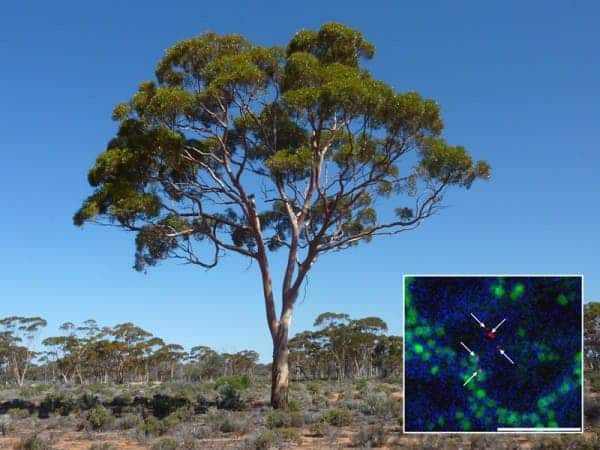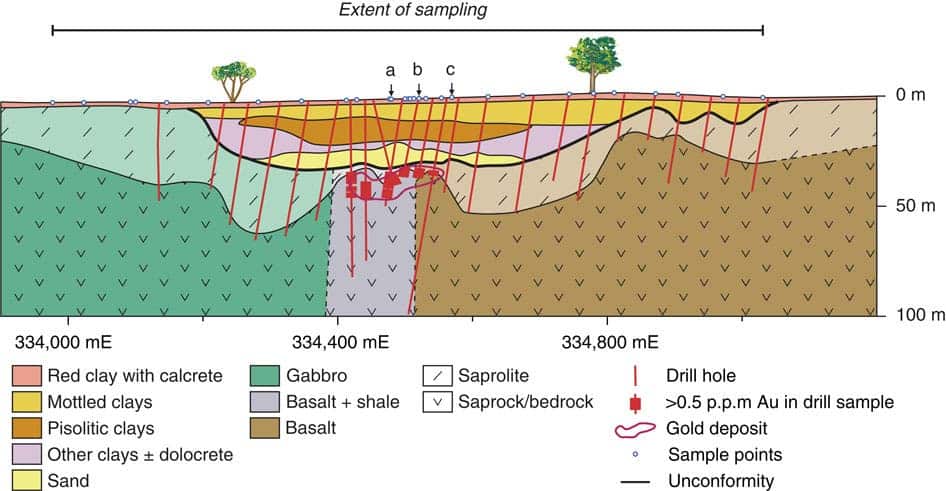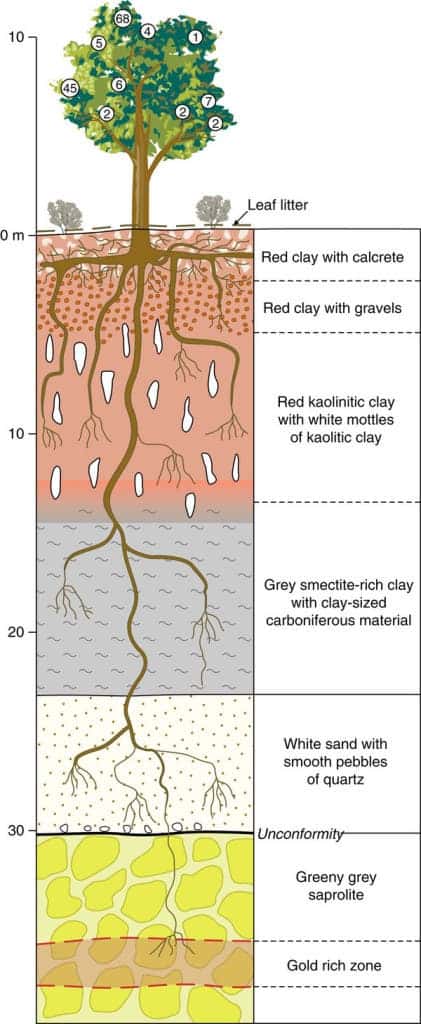
The old saying “money doesn’t grow on trees” is often recited to remind squandering youth of the value of a hard-earned buck. Things turn really funny when you hear that gold, as in the actual glittering chemical element that money is used to be based on, grows on trees. In Australia, to be more precise, geochemists at CSIRO’s Earth Science and Resource Engineering division in Kensington found that trees that grew on gold deposits had a concentration of gold particles at the surface of their leaves 40 times higher than trees that grew on normal soil.
The tree studied by the researchers led by Mel Lintern, a geochemist with the Commonwealth Scientific and Industrial Research Organisation (Australia’s national science agency), is a certain Eucalyptus tree that grew above a known gold deposit.
The deposit is about the size of a football field and lies at least 30 meters below ground – too little for too much of an effort to be worth the exploitation. What scientists have learned after gathering twigs, bark and a myriad of trees, however, may be of greater value. Imagine prospecting operations that are both cheap and non-invasive: as easy as putting a leaf under a microscope.
You see, after comparing the same vegetation from trees growing 200 meters away from the ore, the researchers found the ‘golden’ Eucalyptus measured 40 times more background gold concentration or 80 parts per billion (ppb).
This find came from a site in Western Australia, so the researchers wanted to see if similar results can be discovered in other areas. In Southern Australia, at another site, the researchers showed that eucalyptus trees growing above a deposit lying 35 meters underground had 20 times more gold in the gummy substances coating their leaves than did trees that grew 800 meters away.
Their data suggested that the trees, which have roots extending up to 40m below ground, had absorbed particles of gold while searching for water during droughts, and transported to their leaves, twigs and bark.
Scientists have known for some time that trees gather tiny gold particles at the surface of their leaves, but the only viable explanation they could find at the time is that these were collected by the leaves from winds carrying and sweeping gold particles found at the surface.
To verify the gold is actually expelled from the soil underneath the trees and not simply gathered from the surface, Lintern and colleagues devised an experimental set-up.
They grew seedlings in greenhouses insulated from airborne dust and watered them with a gold-laced solution. In time, they found the gold accumulated at the surface of the leaves, proving the element was actually absorbed from the soil and expelled later.
Indeed, being a heavy metal, gold may be harmful to trees and the build-up of gold at the leaves’ surface may be the result of a defense mechanism.
“The new research provides “a conclusive set of evidence … from a very nicely constructed set of experiments,” says Clifford Stanley, a geochemist at Acadia University in Wolfville, Canada.
I know what you’re thinking. What if we mine trees? Well, you’d have your work cut out for you. The highest concentration of gold is found in the leaves. If you dry them up, you end up with an even higher concentration. Even so, the largest gold particle the scientists could find was 8 micrometers across or half the width of a human hair. Too thin and too spaced apart. Collecting gold from trees would be too much of a hassle to make anyone bother. But where the gold in trees fails as an ore mine, it shines in its prospecting value.
Engineers could use this information to first measure gold concentration in trees from areas suspected of harboring gold deposits, and only after they find hints would the big guns be called for: geology and geophysics.

Worldwide, new discoveries of the metal are down 45% over the past decade. All the good and easy to find spots are already taken, the next generation of prospecting will require new and ingenious methods to stay on top. Gold growing in trees might find a great part to play.
It’s worth noting that trees aren’t the only unconventional gold prospecting tool. For instance, entomologists at the same CSIRO in Australia found that termites “mine” and stockpile the precious metal while they’re collecting subterranean material for their nests. From the ZME Science article we wrote a while ago:
For the study, entomologist Aaron Stewart, with Australia’s Commonwealth Scientific and Industrial Research Organisation, and colleagues analyzed samples from several termites nests and compared them to soil samples taken from different depths.
Then, by using a mass spectrometer, they found a direct correlation between the amount of gold in the termite nest sample and their proximity to the gold source: the ones closer to the deposit had higher concentrations. A mass spectrometer analyzes the chemical make-up of the sample, by measuring the the mass-to-charge ratio of charged particles.
Also, plants have been used before to find gold – a prospecting technique called gold phytomining (when animals are used to mine it, it’s called biomining).
Using certain hyperaccumulators – plants that have the natural ability to take up through their roots and concentrate metals such as nickel, cadmium, and zinc in their leaves and shoots – scientists found that under certain chemical conditions, gold solubility can be forced. Some have proposed using phytomining to extract gold, essentially growing gold but it’s been found to be unfeasible. This latest research, however, is the first to show gold grows on trees.
The natural gold particles growing in Eucalyptus trees finding was reported in a paper published in the journal Nature Communications.
Editorial note: The metaphor “gold grows on trees” shouldn’t be taken literally. Gold particles are absorbed from the soil beneath the tree and then expelled at the surface of vegetation.







